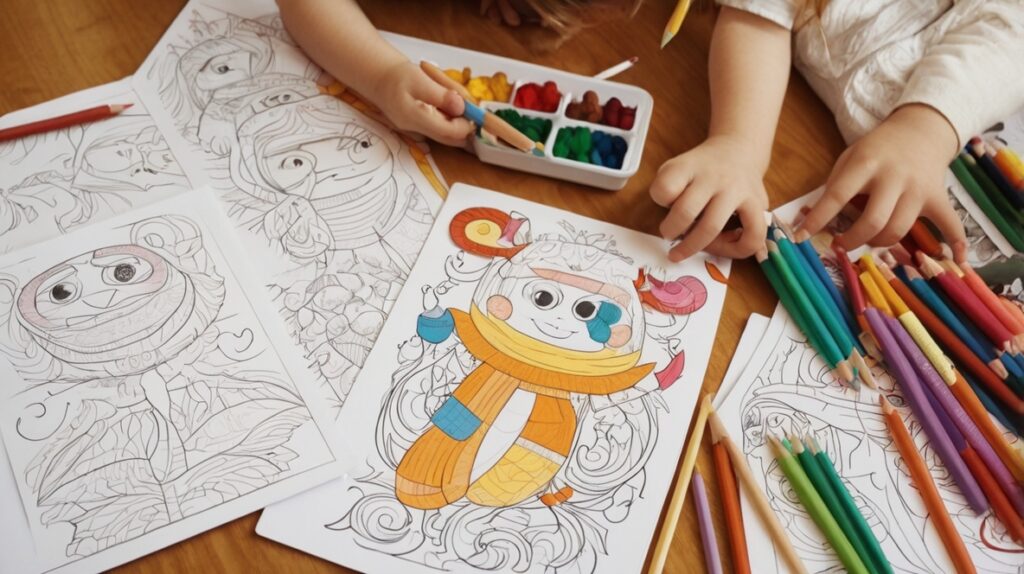Coloring isn’t just a fun pastime—it’s a powerful educational tool that fosters creativity, improves motor skills, and enhances cognitive development in children. Whether used at home, in school, or as a therapeutic activity, educational activities to color can transform the way kids engage with learning. In this article, we’ll explore a variety of interactive and engaging coloring activities designed to educate and inspire young minds.
1. Educational Activities to Color: The Benefits of Coloring in Child Development
Coloring plays a crucial role in childhood development. Beyond being an enjoyable activity, it provides essential cognitive and physical benefits that support academic growth. Here’s how:
- Enhances Fine Motor Skills: Holding crayons and coloring within the lines strengthens hand muscles and coordination.
- Boosts Concentration and Focus: Completing a coloring page requires patience, teaching kids to focus on a task from start to finish.
- Encourages Self-Expression: Choosing colors and creating artwork helps children express their emotions and personalities.
- Aids in Learning Colors and Shapes: Early exposure to different colors and shapes helps children recognize and differentiate them quickly.
- Improves Hand-Eye Coordination: The act of coloring improves the connection between visual perception and physical movement.
2. Using Coloring to Teach Letters and Numbers
One of the most effective educational activities to color involves integrating letters and numbers into coloring pages. This method helps preschoolers and early learners become familiar with fundamental concepts before formal schooling. Some ideas include:
- Alphabet Coloring Pages: Each letter is associated with an image, such as “A” for apple, reinforcing phonics and vocabulary.
- Number-Based Coloring: Kids color by number, helping them associate numerals with their corresponding quantities.
- Tracing Activities: Combining coloring with tracing letters or numbers supports handwriting development.
- Math-Themed Coloring Pages: Simple addition or subtraction problems guide children to color specific sections, making learning math fun.
3. Science and Nature-Inspired Coloring Pages
Science and nature themes provide an excellent way to introduce children to the world around them while keeping them engaged. Some exciting ideas include:
- Animal Classification Pages: Kids color and learn about mammals, reptiles, birds, and amphibians.
- Life Cycle Coloring Sheets: Depict the life stages of butterflies, frogs, or plants.
- Solar System Coloring Pages: Teach kids about planets, stars, and space exploration through interactive coloring sheets.
- Human Body Diagrams: Engaging coloring pages that illustrate organs, muscles, and bones in a simple, child-friendly manner.
4. Cultural and Historical Coloring Activities
Introducing history and different cultures through educational activities to color fosters awareness and appreciation for diversity. Some creative ideas include:
- Historical Figures and Events: Coloring pages featuring famous figures like Martin Luther King Jr., Leonardo da Vinci, or ancient civilizations.
- World Landmarks Coloring Sheets: Explore the Great Wall of China, Eiffel Tower, and Egyptian pyramids through coloring.
- Cultural Festival Coloring Pages: Children learn about Diwali, Christmas, Hanukkah, and Lunar New Year through themed artwork.
5. Themed Holiday and Seasonal Coloring Pages
Coloring pages tailored to specific holidays and seasons add a festive touch to learning. Popular options include:
- Halloween-Themed Coloring: Fun ghosts, pumpkins, and friendly monsters to celebrate the spooky season.
- Winter Wonderland Pages: Snowflakes, igloos, and penguins to introduce kids to cold-weather wonders.
- Spring Nature Scenes: Flowers, butterflies, and Easter eggs bring the season to life.
- Thanksgiving and Christmas Pages: Festive turkeys, Christmas trees, and Santa Claus create a cheerful learning environment.
6. Encouraging Creativity Through Freeform Coloring and Doodling
While structured coloring pages provide educational value, freeform drawing encourages unrestricted creativity. Some activities include:
- Create-Your-Own Story Coloring Sheets: Kids draw and color their own characters and settings.
- Doodle Challenges: Prompts such as “Draw an underwater city” or “Create a new planet” inspire imaginative thinking.
- Color Mixing Experiments: Let kids explore color blending by mixing crayons or watercolors on a blank sheet.
7. Interactive and Digital Coloring Activities
With advancements in technology, digital coloring has become a popular and accessible educational tool. Some digital options include:
- Coloring Apps: Platforms like Crayola Color Studio and Colorfy provide interactive, mess-free coloring.
- Printable and Augmented Reality Coloring Pages: Some websites offer pages that come to life through augmented reality (AR).
- Online Educational Games with Coloring Elements: Platforms like ABCmouse and PBS Kids integrate coloring into learning games.
Conclusion: Making Learning Fun with Coloring
Incorporating educational activities to color into daily learning routines can significantly benefit children’s development. From improving fine motor skills to reinforcing academic subjects, coloring transforms learning into an engaging experience. By providing a mix of structured and freeform coloring activities, parents and educators can ensure that children develop essential skills while having fun.
Coloring is more than just a pastime—it’s a gateway to creativity, self-expression, and lifelong learning. Whether using traditional crayons, digital tools, or themed worksheets, these activities help shape young minds in an enjoyable and effective way. So grab some colors and let the learning begin!
